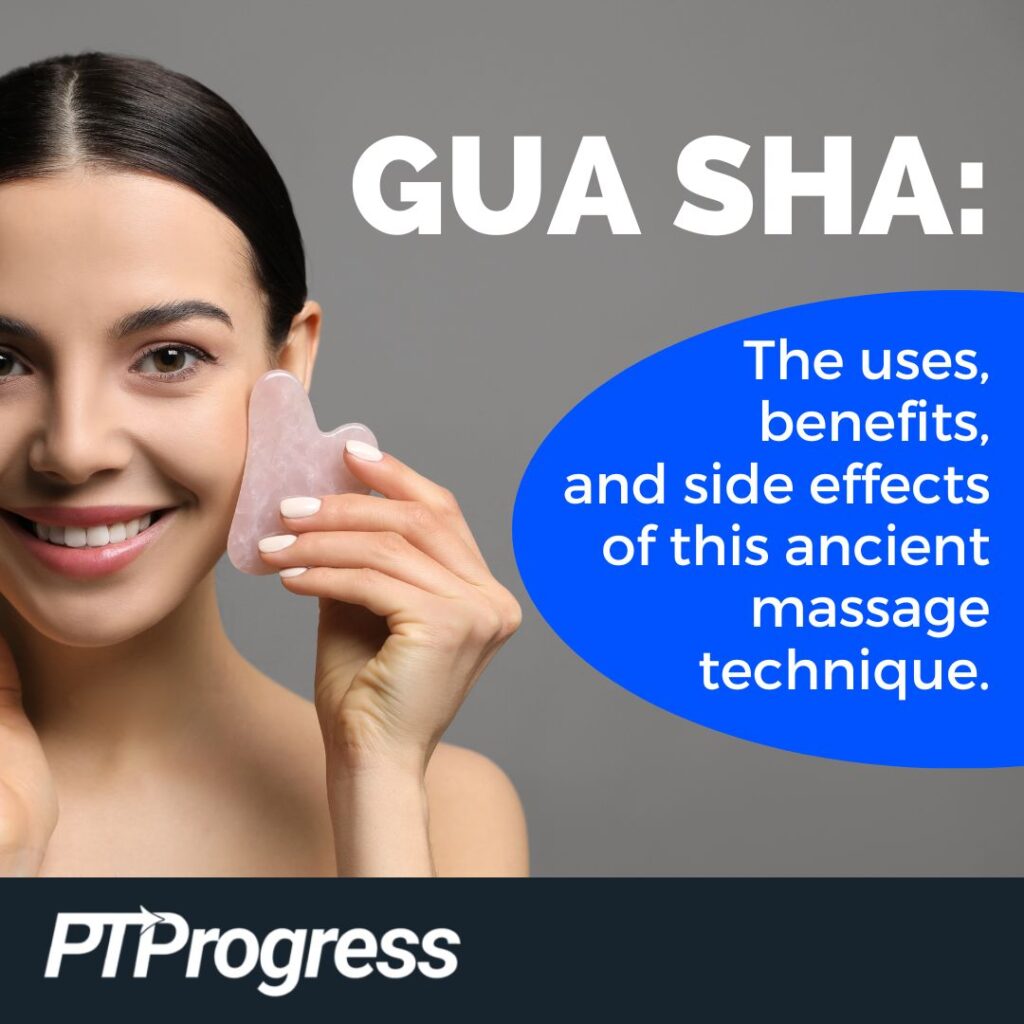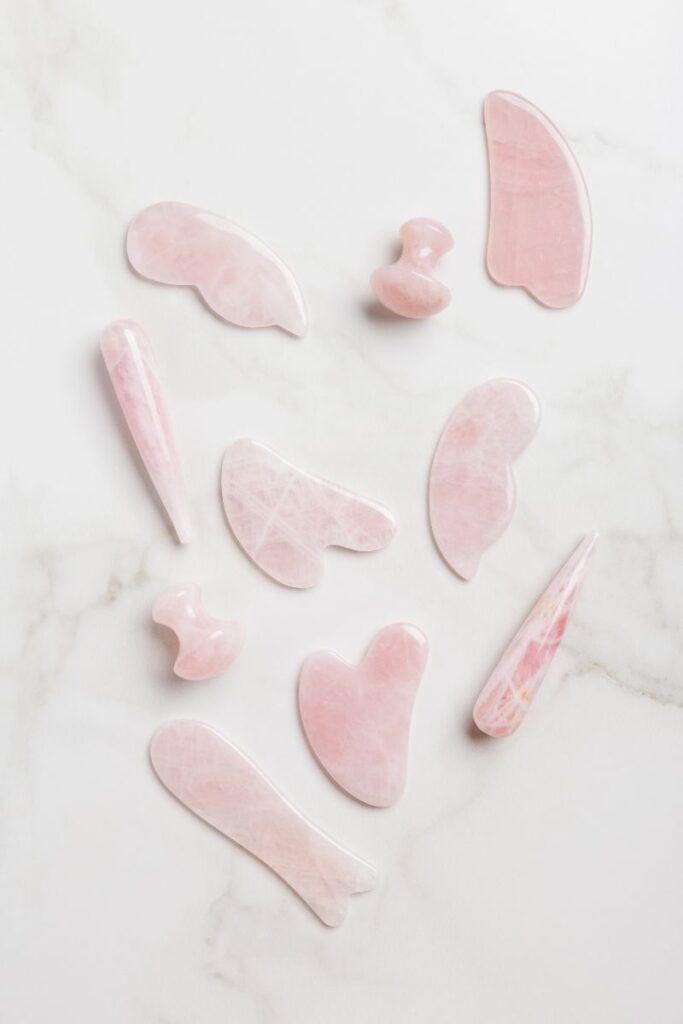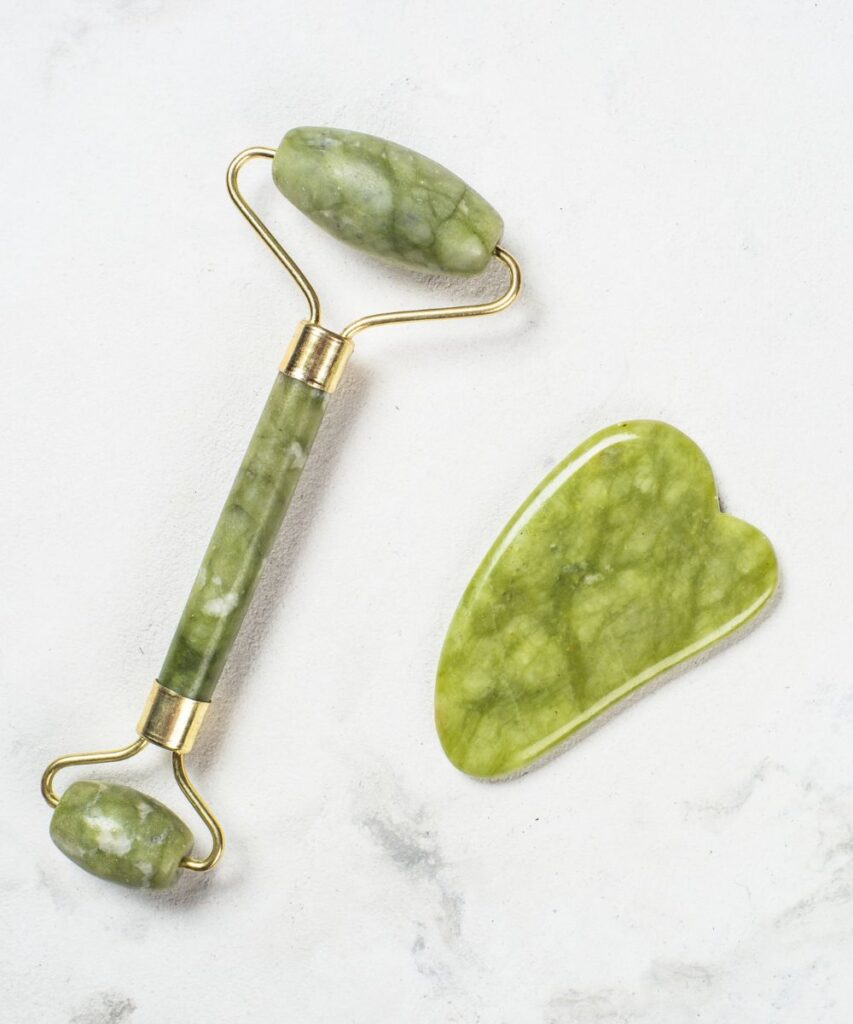
If you spend any time on beauty blogs, you’ve undoubtedly seen videos of youtubers scraping their faces with a heart-shaped gemstone tool. So you may be surprised to learn that this technique, called gua sha, is similar to what we use in physical therapy to relieve muscle pain.
To learn more about gua sha and how it can help you, read on!
Overview
Although gua sha has become somewhat of a trend in the last few years, it’s been around for millenia. Tracing back to the 3rd century BCE, gua sha is a method of Traditional Chinese Medicine (TCM) originally used to direct blood flow.
In TCM, illness is attributed to a disruption in your body’s energy or qi. Dislodging that interruption by promoting blood circulation can, by that theory, expedite the body’s natural healing process.
Gua Sha and Physical Therapy
From a physical therapist’s point of view, gua sha is just another type of instrument-assisted soft-tissue mobilization technique. We have several types of these techniques, all under the umbrella acronym IASTM.
When you have inflammation and stiff muscle knots, mobilizing the soft tissue can help reduce pain while promoting healing. Some practitioners believe IASTM can even help lengthen muscle fibers and break up scar tissue.
All in all, there’s good indication that gua sha, in the right set of hands, can provide pain-relieving therapy similar to what we administer in the clinic.
Gua Sha vs. Graston Technique®
In Physical Therapy, we have one method that bears considerable resemblance to gua sha, called the Graston Technique®. David Graston was a machinist and amateur athlete who, after injuring his knee skiing, grew impatient with his recovery. In coordination with physicians and researchers at Ball State University, he developed a set of steel, concave tools to use on his injury and help speed its healing. His positive experience has been replicated, validated, and now patented as the Graston Technique® (or simply GT).
Graston’s tenacity is admirable, but at the core, his technique is not much different from IASTM or gua sha. Instead of a jade rock, a GT practitioner chooses from a set of 6 stainless steel implements, each shaped to fit a particular muscle group or size.
The 6 instruments—as well as professional training and certification—are required to practice GT. But aside from these stipulations, the main difference between gua sha and GT is that the former follows traditional Chinese medicine and the latter in western medicine, where the focus is more on muscle and tissue than on blood circulation and qi.
Uses of Gua Sha
Whether it’s gua sha, Graston Technique®, or some other IASTM method, tool-assisted massage can help a variety of ailments.
Traditionally, people used gua sha to mitigate symptoms of cold viruses and of heat stroke. Today, however, its primary use is musculoskeletal therapy, from reducing tension and decreasing inflammation to improving circulation and relieving pain.
Therefore, gua sha can best help people with chronic pain, such as arthritis, fibromyalgia, peripheral neuropathy, and even repetitive stress injuries such as carpal tunnel syndrome.
More recently, gua sha has been marketed as a cosmetic technique for facial massage. The idea behind a facial application is that the scraping motion helps reduce inflammation and puffiness by draining sluggish lymph. Newly circulated blood then flushes the face with youthful vigor—or so the promise goes.
Although gua sha may not be as effective for anti-aging beauty as retailers would have you think, many of its other benefits have been well supported by research in recent years.
Research Behind the Benefits of Gua Sha
Under the right touch, gua sha can bring about a slew of health benefits. Like with any massage, gua sha can ease muscle tension and help you relax, a necessary antidote for soothing tight muscle knots.
One of the primary reasons people seek out gua sha is for pain relief—a benefit that’s becoming increasingly more empirically evident. In this 2017 study, patients with chronic low back pain either used a hot pack or underwent gua sha therapy as a way to treat their pain. Although both sets of patients showed decreased pain and improved flexibility (yay!), the effect was stronger and longer-lasting in the patients receiving gua sha therapy.
Research suggests gua sha can also help prevent muscle injuries. For example, patients with tightness in their ankle flexibility (dorsiflexion) experienced a greater range of motion after regular gua sha treatments. Better flexibility can reduce the risk of injury later on.
Another 2017 study of 75 women suggests that gua sha can help treat symptoms of perimenopausal syndrome, such as insomnia, fatigue, and headache. Numerous case studies also acclaim the wonders of gua sha, from treating hepatitis B and tourette syndrome to ameliorating migraines and heel pain.
Beauty Research
Regarding the popular beauty claims of gua sha, there is one major study to back them up. Participants in this 2018 study were given a 5-minute facial massage to one cheek. The side that received the massage showed better facial circulation for up to 10 minutes afterwards. These results also became more robust over the long-term, with participants showing better vasodilation in their cheeks over the course of the 5-week treatment.
As a side note, the researchers in this last study used a facial roller to administer their massage. So let’s take a closer look now at the tools of gua sha.
- BENEFITS OF GUASHA: It is a traditional Chinese medicine therapeutic treatment, helps to promote blood circulation, reduce puffiness, sculpt the…
- EXCELLENT DESIGN: The specially designed Gua Sha tool provides a more efficient, smooth, and convenient experience. Its smaller size perfectly fits…
The Tools of Gua Sha
When gua sha was the best-kept secret of Chinese peasants in antiquity, there were no standard set of tools. A spoon, coin, animal bone, or simple one’s own hard knuckles could serve the purpose of therapeutic scraping.
Fast forward a couple thousand years, and marketing schemes now depict gua sha with gemstone tools in concave shapes and crystal colors meant to symbolize spiritual attributes of the healing process. Today’s practitioners most commonly use jade, rose quartz, obsidian, and amethyst to administer their massage.
Besides its durability, from a PT’s perspective there’s no advantage to using one gemstone over another. In fact, because gemstones are porous, they’re more likely than a nonporous material such as stainless steel to harbor bacteria. Therefore, if you use a gemstone tool, be sure to wash it after every use—especially if you experience any bleeding.
Gua Sha vs Jade Roller
After a brief internet search you might think gua sha is synonymous with jade rolling. Although they both hail from traditional Chinese medicine and boast similar results, gua sha and jade rolling differ in a few important ways.
First, the hardware: a gua sha tool is a single piece of material. A jade roller comprises a metal apparatus affixed with one or two revolving stones.
The gua sha tool can administer a strong massage to all parts of the body, from large muscle groups to tender tissues in the neck and face. Its history goes back to the third century BCE and was popular among the working class.
Jade rolling, on the other hand, is typically only for the face, and its history is less well-known. Many articles (including this one now) purport that jade rolling was a beauty regiment of 17th-century Chinese royalty.
Because jade rolling is fast and easy to administer, it’s the tool of preference for gua sha facials. However, without the clefts or divots of a free-standing gua sha tool, the roller is limited in the type and intensity of facial massage it can give.
Luckily, you don’t have to choose between the two. Many facial kits come with both a gua sha tool and what’s termed a jade roller, whether or not it’s made from jade.
FAQ
What does “gua sha” mean?
According to TCM, the name “gua sha” refers to the scraping motion (“gua”) employed to lift the blockage (“sha”) that’s disrupting your qi. In fact, this word “sha” is also used to describe the red spots that arise from a gua sha session, which western practitioners call petechiae.
Is Gua Sha legit?
Although its cosmetic anti-aging claims may be overstated, gua sha is a legitimate type of soft-tissue mobilization which PTs use in the clinic to reduce inflammation, decrease pain, and promote healing.
Does it hurt?
That depends on how well you tolerate other types of instrument-assisted soft-tissue mobilization. The scraping and pulling motions of the gua sha tool may cause redness and even bruising or bleeding. But it shouldn’t be painful—just slightly uncomfortable. Besides, the increased blood flow afterwards should erase those feelings of discomfort and replace them with restorative relaxation.
What are the risks of gua sha?
Because mild bruising often occurs, gua sha isn’t recommended for people taking blood thinners. It’s also not ideal for anyone prone to blood clots, varicose veins, or deep-vein thrombosis. Additionally, gua sha tools can harbor pathogens and, if bleeding occurs, transmit bloodborne illness. So make sure you receive gua sha only from a professional under strict hygiene standards—and follow regular cleaning practices for your own tools at home.
Can I do gua sha at home?
You don’t have to visit a PT clinic or schedule an expensive facial to reap the benefits of gua sha. Look online and you’ll find plenty of gua sha tools for sale, as well as video tutorials available for free.
How long should I perform gua sha?
For best results, keep facial sessions short but frequent: 3–5 minutes a day, 3 days a week. On the other hand, a full-body gua sha treatment by a trained practitioner can last anywhere from 20–60 minutes.





